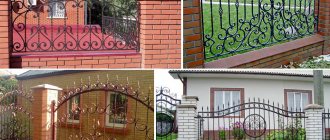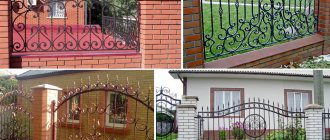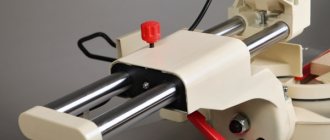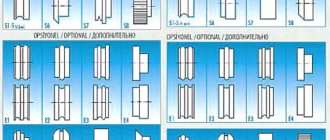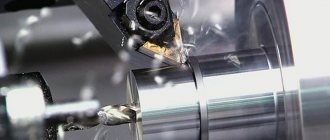Sometimes in the lives of people living “on earth” there are moments when you want to do something with your own hands, without putting it off. Someone is thinking about carpentry, someone is engaged in the manufacture of decorative products, and someone is literally passionate about forging. Moreover, real, i.e. - “hot.”
So, in this article:
- What is the minimum set of tools and equipment needed for forging.
- How to make an anvil from an old rail.
- What can you use to construct a portable forge?
Types of forging machines
The undoubted advantages of cold forging of metal include the fact that there is no need to build a forge and install equipment and devices, without which work is simply impossible (forge, anvil, etc.).
Homemade forge for forging
Anvil for forging metal
Cold forging of metal can be automated, and without much difficulty. This solution guarantees increased efficiency in the production of products. Even non-automated production allows you to increase labor productivity, that is, it allows you to produce entire batches of parts according to a given sample, in other words, there is always the possibility of organizing small-scale and mass production. This is especially beneficial when placing large orders, for example, in the manufacture of fences, window bars, etc. There is no need for large areas to set up a cold forging workshop.
During cold forging of metal, there are no changes in the internal structure of the metal, and this leads to the preservation of the strength characteristics of the metal. When cold forging metal, there is the possibility of artificial aging of the metal and this allows the production of antique parts.
In general, we can say that the use of cold forging technology allows us to produce relatively inexpensive products with high quality.
How to make an anvil from an old rail
The experience of a portal user with the nickname DIMDIM is interesting. He tells you what can be achieved when making homemade products if you apply your ingenuity to the matter.
DIMDIM FORUMHOUSE Member
I decided to take up forging. I watched a lot of videos online and came to the conclusion that I could make the entire instrument myself. First of all, I need an anvil, a forge, and various accessories. To save money, I will make everything from what I have in my “bins”, i.e. from scrap materials.
From the Internet, the user learned that most often a homemade anvil is made from a railway rail.
Because there was no rail in the “bins”, DIMDIM involved all friends, relatives and acquaintances in the search for the “donor”. Soon the search was crowned with success, and the user became the owner of an old but strong rail.
All that remains is to cut off everything unnecessary from the workpiece and give it the desired shape. Having uncovered the metal cutting machine, the user began to work.
According to DIMDIM, it took four hours to cut the rail, made from high-carbon heat-treated steel, into two pieces and trim it, with regular stops for the cutter to allow it to cool.
Then came the turn of making the so-called. “horns” of the future anvil. Because The sawn-off part of the rail did not fit at the required angle on the cutting machine bed, so we had to disassemble the clamping device and connect the bed to an additional table.
The user had difficulty cutting the rail into a triangle, then the tedious work of giving the anvil “horn” the desired shape began.
The work was carried out alternately using an angle grinder, a cutting machine and various fasteners and pads.
This work took another 5 hours.
DIMDIM
Having made the blanks, I started assembling the anvil and tried to connect all the parts together. Because the rail was crooked and the parts could not be connected. My friend and user of the Movik portal helped me out.
A member of FORUMHOUSE suggested DIMDIM to assemble an anvil on a frame, which was used as a steel counterweight from an elevator. As the author of the idea, Movik welded all the parts into a single structure.
The next stage is the production of a square hole in the “tail” of the anvil, which is necessary for fastening various devices - mandrels, staples, bending forks and cones, the shank of which has the same cross-section as the “receiving” hole.
When making an anvil on their own, craftsmen make the “square” in different ways. The hole is burned with a welding machine, drilled and then finished with a file. The user simplified his task - taking a grinder, he cut a groove in the rail, and then welded a corner made from a T-shaped guide from an elevator to the end.
When assembled, the anvil took on the following appearance.
The user also made a set of attachments for the anvil.
Hot Forging Equipment
If we compare the cold and hot forging methods, we can immediately say that the first method requires much more skill from the worker, the presence of some artistic skills and, of course, the ability to work with a set of necessary tools.
Hot Forging Equipment
Forging of the material occurs after it is preheated in a forge furnace. It's called a forge. The forge is equipped with equipment for forced air supply. Heating is carried out to a given temperature and then transferred to the anvil. This is a metal plate on which impact processing of a heated workpiece is carried out. It is performed using hammers and sledgehammers of different weights. One worker, with a light hammer, strikes the desired place, and the second, armed with a heavy hammer or sledgehammer, strikes a strong blow to the designated place. After the workpiece has cooled, it is again loaded into the oven for heating. All movements of the part during its processing are performed using pliers with long handles.
Hand hot forging
In addition to the above-mentioned basic tools, during hot forging, many special tools are used that allow cutting hot metal and forming complex surfaces during hot forging of metal.
Forge
To heat the workpieces, furnaces are used, which are called forges. Its design includes several components. In particular:
- barrel made of fire-resistant material;
- hearth, with built-in grate;
- air supply and exhaust systems;
- working window through which long workpieces are fed;
- a chimney through which combustion products are removed.
Gas forge forge
In addition, the forge also includes a quenching bath. The operation of a classic forge is based on the unique reducing ability of carbon. It is this ability that successfully resists the oxidation of the workpiece, that is, its combustion. The calorific value of carbon is also important here. The fact is that when supplying air, it is necessary to regulate its quantity. There should be enough of it to burn the carbon, and the heat generated will raise the temperature in the furnace even higher.
In addition, the air supply to the forge must be adjusted so that the supplied oxygen is not enough to oxidize the metal. But if the heated workpiece is kept in this state for more than the required time, then it will become oversaturated with carbon. There is such a term - overdrying, that is, the metal becomes very fragile. By the way, cast iron can be used as an overdried metal.
Muffle furnace
Equipment that is used to heat parts made of different materials to a given temperature is called a muffle furnace.
Muffle furnace
A distinctive feature of this equipment is the presence of a muffle. So, they call a part that protects the part from contact with fuel and combustion products and at the same time serves as a chamber in which the part is heated. In practice, two types of such furnaces are used, with a permanent and replaceable muffle. In the first furnace, the loaded parts undergo all operations - from heating to readiness, in the second, only until cooling. That is, as the required temperature and a certain holding time of the workpiece are reached, one muffle is removed and another is installed in its place.
It should be noted that both the forge and muffle furnaces can use different types of fuel - gas, coal, firewood, light and dark oil products, etc.
Anvil
One of the key tools used for both cold and hot forging of metals is the anvil. It is on its surface that blacksmiths deform the workpiece and bring it to a finished form. The anvil is heavy and therefore it is rigidly fixed to a wooden block.
Anvil - Key Tools
The structural anvil consists of:
- horns;
- platband with holes;
- bases with paws for installing an anvil.
For the manufacture of this tool, 45L steel is used. It should be noted that anvils are products manufactured in accordance with a number of GOSTs. For example, GOST 11396-75 normalizes hornless products weighing from 92 to 200 kg, and GOST 11398-75 defines the requirements for products with two horns and weighing from 100 to 270 kg.
The hardness of the material from which anvils are made is 340 - 477 HB.
How much is a pound, or Choosing equipment for a forge
How much is a pound...
We know that among our readers there are also those who are simply interested in artistic forging. They like pictures depicting artistic forging products. They taste quite good.
The next group of readers are home craftsmen. They make various products with their own hands, including metal work.
And to our colleagues, special respect and honor.
Why am I writing all this to you? This article is of interest to the last two categories of our readers. Because it will touch upon aspects of creating forging production and everything connected with it.
We'll tell you how our first forge was created. Back in the early 2000s, when finishing building a house, we had to order forged metal structures. Namely, the entrance group. After visiting the forge, we plunged into the unknown world of metalworking. In the semi-darkness the rhythmic sound of hammers on anvils could be heard. In itself, it seemed like the sounds of an orchestra performing a popular piece. And music connoisseurs would undoubtedly pick out several excerpts as their favorites. All sorts of then unknown metal devices were hung all over the walls. And the inquisitive mind was already there beginning to look for a logical explanation for their use. And the very atmosphere of the dimly lit room brought a mystical feeling.
A brightly burning torch on the table could not help but attract the attention of visitors to the forge. It was only later that we learned its name. That's right - a blacksmith's forge. Sheaves of sparks flew everywhere and hissing was heard. It was as if someone unknown was saying: “Hush, pay attention...!” And in fact, moving between the working craftsmen, every now and then they noticed white-hot metal, or a hot workpiece bursting with steam and falling to the floor. Which once again indicates compliance with safety regulations in hazardous industries. Which includes blacksmithing. Work related to metal often involves the use of heating the metal to high temperatures, welding work, and the use of various metalworking machines and mechanisms. We'll talk more fully about the design of the forge a little later.
Where to start, you ask? We recommend starting with the most important equipment - the anvil. We have already written about what types of anvils exist. An anvil is one of the main tools of a blacksmith who produces hand-made artistic forging products.
Despite the developed sales of ready-made forged elements, real craftsmen, as in ancient times, make most products by hand.
How to distinguish manual work from blacksmithing and metalworking? Very simply, with hand forging, a texture appears on the surface of the elements. It is caused by hammer blows on a forging. Later, with painting and patination, this texture becomes more obvious. On “cold forged” products this texture is absent or less pronounced. And the very sketch of a product made by “cold forging” masters is not original and is most often monotonous.
But back to the anvil! The weight of the anvils is standard kg kg kg. At the initial stage, do not chase the weight of the anvil. The first anvil standing in the forge was a 70 kg one-horned anvil. Later, with the development of production, we introduced Regulations for equipping production facilities. Two anvils had already been purchased there. One with a weight of more than 100 kg and the second with less weight. We installed the anvils as standard. The large anvil, being the main one, was placed permanently on a wooden birch block. Loggers were ordered birch logs with a diameter of 444 mm. The main difference was its branched structure, which contributed to its strength. More often, such birch trunks grow near swamps. Later, after drying, we use the same material to make wooden handles for the tools. So we recommend taking a good birch log larger than necessary and putting it in the “bins” for future use. The second anvil, with less weight, is movable in production. It is installed on a metal workbench that has a trapezoidal shape. She allows herself to be moved around the assembly shop and becomes “in the right place at the right time.” Another advantage is the special places for storing hand tools located around the anvils. They allow the necessary tool “to always be at hand.” Each blacksmith places his tool around the anvil as he works.
The main working surface of the anvil is the face. It is the condition of the working surface that you should pay close attention to when purchasing this item. There should be no deflections on the horizontal surface caused by long work or mechanical deformation. You need to check this using a metal ruler mounted on the end along the horizontal working plane of the anvil. The same procedure must be carried out in the transverse direction.
The next thing you should pay attention to is the condition of the corners along the entire edge of the working surface. The angles are designed for bending workpieces, and the closer they are to the ideal, the better you will bend the workpiece.
It is important to pay attention to the condition of the working holes on the working surface of the anvil. The standard size holes are 30x30mm or 35x35mm. They are intended for installing various auxiliary tools for the anvil. We will mention it further.
The more firmly the device is installed and fixed, the better and more accurately the hammer blow will be performed. The edges must not have visible damage or be deformed.
The next point to pay attention to during visual inspection is the surface of the anvil horn. It is with its help that the blacksmith bends the elements of the product. The smoother the surface of the horn, the fewer unnecessary defects the forged workpiece will have.
Be sure to give a few gentle blows to the anvil with a hammer. You should hear a ringing sound of impact. If the sound is muffled, it means that the anvil has defects and cracks that are not always visible to the naked eye.
Pay attention to the lower part where the anvil was previously attached to the base. Deep grooves on the paws will tell you about long-term use and subsequent surfacing on the working surface of the metal.
Often, for a faster sale, the seller carries out pre-sale preparation, that is, paints. A coat of paint applied over the rust will also tell you about the anvil's rich history.
And now you have a quality anvil lying in your garage. Now it’s time to think about the premises where the work on the production of forged products will be carried out. There are no clearly formulated requirements.
The next “inseparable friend” of the master is the forge. Its purpose is to heat a metal workpiece to the required temperature. Depending on where you live, it’s worth deciding on the main question. What will be the fuel for your forge. It could be coal or gas. The forge can also be stationary or mobile. A mobile forge is often needed to participate in any events, blacksmith festivals, or competitions. At the initial stage, when the master gains experience, such a forge is not necessary. Although you can argue with that!
The forge is a work table with a charge located more often in the middle. A tuyere is a small depression into which coal is poured and air is supplied under pressure using a blower. Thereby raising the temperature, which affects the workpiece.
The tuyere itself is made of thick sheet metal. In the shape of a trapezoidal depression. The nozzle itself is made in the form of several holes. The blower itself is an electric motor with an impeller. We use special components
Let us tell you what this equipment is.
Working in a forge, any blacksmith understands that the use of manual labor is not always justified. And the second most important assistant in the forge has long been the blacksmith’s hammer. After talking about the characteristics and operating principle of a pneumatic hammer, you can read in our article “The hammer is different to the hammer, but the blacksmith is a friend.”
Reading various literature and forums, we realized that there are “helpers” in the form of pneumatic hammers, spring-type hammers (usually homemade), and hammer hammers with a large sledgehammer. The latter is used less and less.
The main characteristic of the hammer is the magnitude of the mass of the falling part. The most common are hammers with a mass of 50 kg and 75 kg. As for brands and characteristics, we are ready to send you technical data sheets for the equipment you are interested in.
When purchasing a used hammer, you should pay attention to the following points.
First, during negotiations with the seller,
- Find out the history of this equipment. This will allow you to assess who is in front of you - the owner of the equipment or an intermediary who wants to make money;
- hammer brand. This is necessary for a more detailed understanding of the characteristics of the hammer and its necessity specifically for your tasks;
- year of issue. Equipment operating time is directly related to the wear and tear of equipment parts. Availability of spare parts for long-life models is not guaranteed. You can purchase a heavy pile of scrap metal rather than working equipment;
- what is the nature of the work performed on the hammer. It’s one thing if the hammer was in the collective farm forge, where from time to time small parts and equipment were forged. And it’s another thing, if the hammer worked at a bankrupt enterprise where there was no blacksmith, and everyone who wanted to worked with the hammer - “killing” the equipment;
- How long has the hammer been in use? Equipment that has not been used for a long time tends to become corroded, and many parts become unusable. And search and replacement can cost a pretty penny;
- the size of the strikers and their condition. The strikers are the main equipment of the hammer; it is by the condition of the strikers that one can judge who operated the equipment and how;
- check whether it is possible to start the hammer upon purchase to check the functionality of the unit. This will allow you to evaluate the truth about the equipment; if everything works, the buyer will be happy to state that turn it on and watch. And if there are problems, then you should think about it too. After all, no one will buy a car without making sure that all the components work.
Get additional photos of the hammer from all angles. There should be no visible defects or missing covers, oil injection station, belts, casings, levers, tubes. Is there electrical equipment needed to connect the hammer?
As soon as you receive all the necessary information and decide on the feasibility of the purchase. It is necessary to move on to specific actions. Go and watch the hammer at work.
Tip: take a bearing ball with you. If it is impossible to connect the hammer: lift up the upper working rod (woman) using a metal crowbar. Be sure to use caution. Before lifting, make sure that nothing is obstructing the operation being performed. Place a metal ball between the hammer heads and horizontal translational movements and check the play of the upper working part. The presence of play will tell you the degree of wear of the main hammer mechanism.
Advice: you can find a lot of correct and correct information on specialized forums. Having analyzed what you read, you will undoubtedly make the right decision on purchasing a forging hammer.
Cold forging machines
To perform cold forging work, various tools and technological equipment will be in demand. Most of the necessary tools can be purchased at any tool store, but some devices may have to be ordered. You can purchase a ready-made set for production and equipment for cold forging.
Cold forging machines
The required tools include a welding machine. There are many offers on the market for the supply of welding equipment, but for the needs of the forge, it makes sense to purchase a device that can work with both direct and alternating current. This device allows you to work with thin sheets without fear of ruining them. An angle grinder is necessary for mechanical processing of workpieces. That is, with its help you can trim something, polish something. Such a machine must have a certain reserve of power and high speeds. A stripping machine won’t hurt either; its services will be in demand if it is necessary to level a weld in hard-to-reach places, for example, at the junction of two planes. Among the power tools that will be in demand are a drill, a hammer drill.
In addition to the listed tools, a set of technological devices will also be needed. For example, a template is used to obtain individual parts; it is used to obtain metal arcs or rings. Without such a device as a volumetric device it is impossible to obtain patterns. Forging equipment for cold forging can be purchased as part of ready-made kits, or you can make it yourself.
Snail machine
Using equipment called “Snail”, the master can make various curls. For greater convenience in work, snails with a collar are used.
Monolithic non-demountable snail
Torsion bar machine
Torsion bar forging equipment is designed to twist the rod along its axis.
Torsion bars - hand forged
To make such a machine with your own hands, you will need the following materials and tools:
- steel sheet;
- I-beam;
- metalworking yews;
- fasteners;
- angle grinder;
- welding machine;
- drive station, which consists of a gearbox and an electric motor.
Gnitik machine
This type of equipment is used for bending rod material or pipes to a certain radius and angle. Working with such equipment does not require significant effort, and after processing on it, the metal does not change its structure.
Bend for cold forging
Gnutiki work as follows. To obtain the finished product, the workpiece is installed between the bending shaft and the stop. The flexible shaft puts pressure on the workpiece, and the stop prevents it from being completely deformed.
Wave machine
Equipment of this type makes it possible to produce wave-shaped products from circles, squares and other types of rolled products. With its help, details such as waves and zigzags are obtained.
Waves for performing wave-like bending of the workpiece
Universal machine for cold and hot forging NK-1 Equipment of the NK-1 brand is an installation, which consists of several blocks and allows you to perform many operations and produce various forged parts, for example, curls, rings, etc. Equipment of this brand allows you to apply a design to metal strips, pipes and other types of profiles. In this case, the cold deformation method is used.

